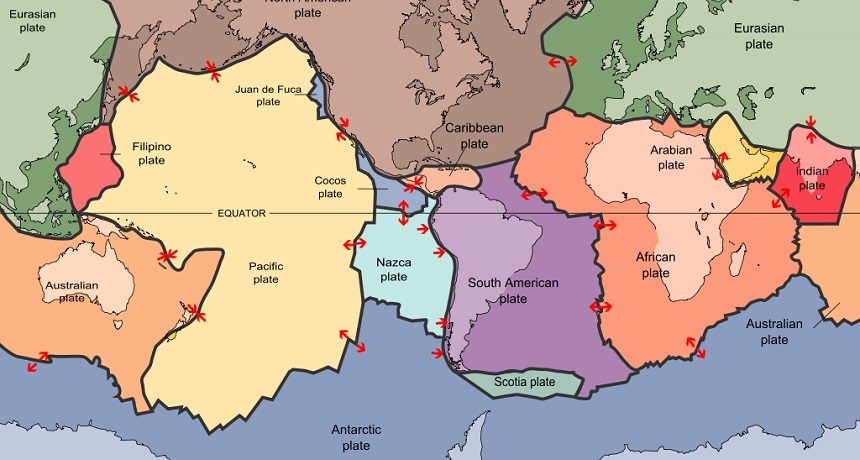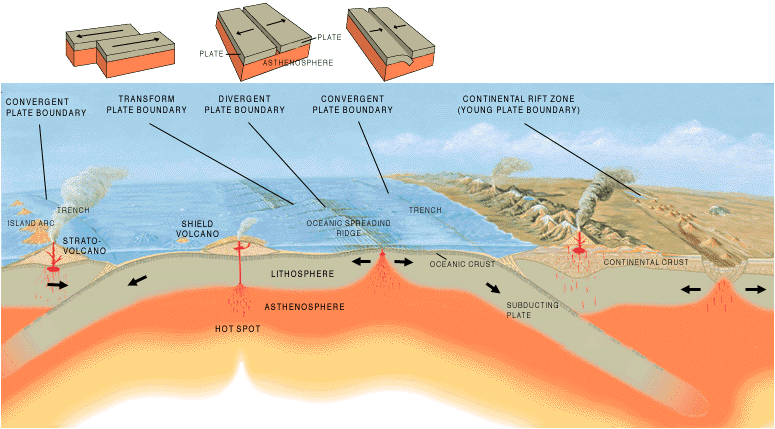Explainer: Understanding plate tectonics
Earth slowly refashions itself over and over

Earth is covered in about a dozen major tectonic plates. Their movement causes earthquakes and volcanic eruptions.
USGS/Wikimedia Commons
For billions of years, Earth has been remodeling itself. Huge masses of molten rock rise from deep inside Earth, cool into a solid, travel along our planet’s surface and then sink back down. The process is known as plate tectonics.
The term tectonics comes from a Greek word meaning “to build.” Tectonic plates are huge moving slabs that together make up Earth’s outer layer. Some span thousands of kilometers (miles) on a side. In all, a dozen major plates cover Earth’s surface.
You might think of them as the cracked eggshell jacketing a hard-boiled egg. Like an eggshell, plates are relatively thin — on average only about 80 kilometers (50 miles) thick. But unlike an egg’s cracked shell, tectonic plates travel. They migrate atop Earth’s mantle. Think of the mantle as the thick white part of a hard-boiled egg.
Earth’s hot, liquid innards also are always in motion. That’s because warmer materials are generally less dense than cooler ones, notes geologist Mark Behn. He’s at the Woods Hole Oceanographic Institution in Massachusetts. So, hot stuff in Earth’s middle “rises up — kind of like a lava lamp,” he explains. “Once it gets back to the surface and cools off again, then it will sink back down.”
The rising of hot rock from the mantle to Earth’s surface is called upwelling. This process adds new material to tectonic plates. Over time, the cooling outer crust becomes thicker and heavier. After millions of years, the oldest, coolest parts of the plate sink back into the mantle, where they remelt again.

“It’s like a giant conveyor belt,” explains geophysicist Kerry Key at the Scripps Institution of Oceanography. It’s at the University of California, San Diego. That conveyer belt drives the movement of the plates. The plates’ average speed is about 2.5 centimeters (roughly an inch) or so per year — about as fast as your fingernails grow. Over millions of years, though, those centimeters add up.
So over eons, Earth’s surface has changed a lot. For instance, roughly 250 million years ago, Earth had one giant landmass: Pangaea. Plate movement split Pangaea into two huge continents, called Laurasia and Gondwanaland. As Earth’s plates kept moving, those landmasses each broke apart more. As they spread and traveled, they evolved into our modern continents.
Although some people mistakenly talk about “continental drift,” it’s the plates that move. Continents are just the tops of plates that rise above the ocean.
Moving plates can trigger huge impacts. “All the action is mostly at the edges,” notes Anne Egger. She’s a geologist at Central Washington University in Ellensburg.
Colliding plates can crush against each other. Abutting edges rise as mountains. Volcanoes can form when one plate slides beneath another. Upwelling also can create volcanoes. Plates sometimes slide past each other at places known as faults. Usually these motions happen slowly. But large movements can trigger earthquakes. And, of course, volcanoes and earthquakes can cause massive destruction.
The more scientists learn about plate tectonics, the better they can understand these phenomena. If scientists could warn people when these events were coming, they also might help limit damage.







